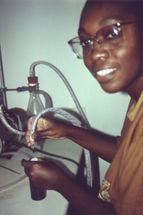Structure of Biogas Programmes
Overview
The structure of a biogas program depends on the stage of biogas development in which the program operates. We have listed below a number of typical forms of biogas programs with their important structural elements. In reality, these programs often represent stages of a longer biogas program. For example, a biogas dissemination program can have a research and development (R&D) phase, a pilot phase, a dissemination phase and a follow-up phase. Often, these phases have large overlaps.
Biogas Research and Development Programs
R&D programs do not aim at widespread dissemination of the technology. They work on improving existing technologies, on innovative designs or on optimizing bio-technological processes. In such applied research it is desirable to communicate and cooperate closely with the potential target group. The laboratory and the research construction sites should actually be on a farm rather than in an isolated compound in town. R&D programs can be attached to implementation programs, they can be part of a national or international agricultural research center or they can be an independent supra-regional project doing research for biogas projects in the region.
Typical structural elements of an R&D program would be:
Central Laboratory to examine chemical composition of substrates, slurry, biogas. To examine qualities of building materials, paints, pipes etc. The head of the lab should be an experienced, practical chemical engineer.
Mobile Laboratory to do on-farm research.
Construction Team consisting of a civil engineer and a small team of technicians and artisans to build and test innovative technological solutions under farm conditions.
Agricultural Team consisting of an agricultural engineer and agro-technicians to research on the use of slurry and stable designs.
Data Bank and Monitoring Unit to collect and process data from the own research and from literature.
Communication Unitheaded by the program manager to link the program with international research and implementation programs.
Biogas Pilot Programs
Pilot programs operate in countries or regions where biogas is not known and biogas technology is not tested. They rely largely on an existing and tested technology which has to be fine-tuned to be fit for widespread dissemination. At the same time the suitability of the region and the selected target groups is counterchecked. The main objective of pilot programs is to receive a constructive feedback of target groups and to alter the technology accordingly. To gain experience under a variety of conditions, typical climatic, topographic and ethnic areas are selected. Their main objective is to make the technology and dissemination approaches fit for widespread dissemination.
Typical structural elements of a pilot program are:
Construction and Agriculture Units for the designated pilot areas, headed by a civil engineer, each consisting of a small team of technicians and artisans. The construction teams may have a store in the respective pilot area with a stock of material and appliances. They construct pilot plants, set up slurry-use facilities and follow-up closely the performance of pilot biogas units.
Training Unit organizes training courses for artisans, technicians and for the pilot farmers. The training unit also uses training facilities in neighboring countries.
Communication Unit is responsible for the communication with NGOs, churches, government institutions and private enterprise in the region. They also keep in touch with international developments.
Data Bank and Monitoring Unit collects data from pilot plants and data from research and literature.
Biogas Dissemination Programs
At a stage when the development of biogas technology is mature enough and target group parameters seem conducive, widespread dissemination can be envisaged. Parallel to the widening of the scope should start a reduction of direct program involvement. In particular the construction part, but also advisory service, planning and follow-up should be increasingly (and the earlier the better) handled by private entrepreneurs. Farmers do not risk technology failure anymore, for that reason they can be expected to carry most of the cost of their biogas unit.
Commercialization Unit develops approaches to make biogas dissemination increasingly independent from program inputs. Elements of their work can be the setting up of credit schemes for biogas farmers and biogas constructors, equipping biogas constructors with tools and other facilities, training entrepreneurs in pricing and accounting and linking biogas enterprise with potential customers. Quality Control Unit monitors built biogas units and gives feedback to constructors. If necessary they advise on re-training or sanctions against unreliable constructors. Public Relations Unit supports the biogas entrepreneurs with PR campaigns to advertise for biogas technology. The PR unit keeps in touch with various government departments to create a conducive atmosphere for biogas. Data Bank and Monitoring Unit (see above).
Biogas Networking Program
Networks usually operate at a supra-national level. They support ongoing initiatives, research and private enterprise in the countries of their region. They normally do not get operational at farm level. Typical tasks would be to organize workshops, training courses or conferences to enhance a south-south technology and know-how transfer.
Typical structural elements would consist of:
Documentation Center including a library and a data bank. Organizational Unit to prepare, organize, carry out and follow up workshops, seminars and conferences. This unit supplies the communication unit with documentation on their activities. Communication Unit to lobby at a government level and with international organizations for biogas, to disseminate relevant information among biogas promoters and researchers in the region and to keep in touch with international developments.
Further Information
References
GTZ/ISAT: Biogas Digest Volume 3: Biogas - Costs and Benefits and Biogas – Programme Implementation




















